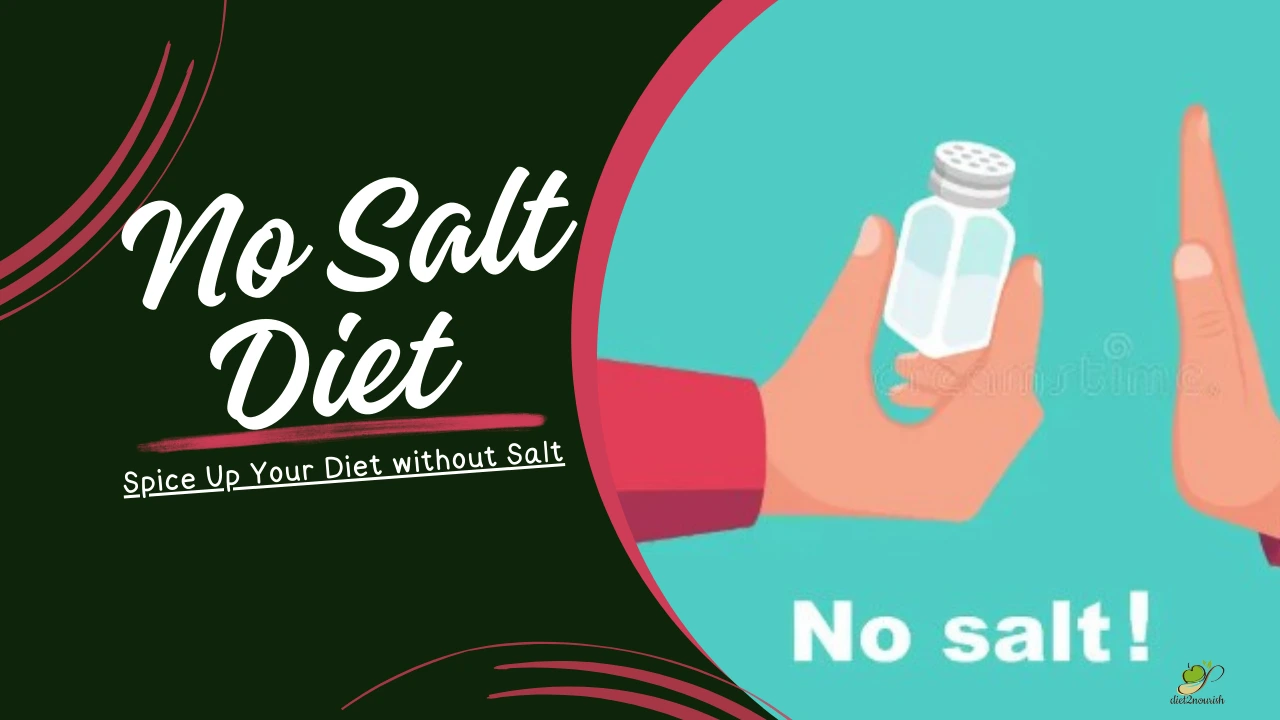No salt Diet Chart
A no salt diet is called a no sodium diet or low-sodium diet. Here, you have to restrict sodium or salt in your diet. You have to say No to high-sodium processed foods.
A no salt diet is a diet plan. It does not involve sodium. You can reduce your salt intake. You need to be careful with the amount of salt you use. Moreover, avoid certain foods with high sodium content. It is beneficial for the body in the long run.
People with various health concerns eat this diet. You can see a dietician for a proper no salt diet chart. They can understand your needs . A dietician will guide you through it.
What are the perks of a no salt diet?
A no salt diet has a number of perks. A few of them are:
● Lowers blood pressure:
Excess salt in your diet can impact your health. Salt retains water in the body. It can increase your blood pressure. A no salt diet can help lower your blood pressure. It can lower your risk of multiple diseases.
● Reduces risk of heart disease:
A no salt diet can reduce your risk of heart disease. It lowers the blood pressure. This diet can keep you safe.
● Improves overall health:
A no salt diet can help with overall health. It can lower your risk of health problems. You can get rid of high blood pressure, heart disease, and stroke. It can help you stay healthy.
● Helps with weight loss:
A no salt diet can help you lose weight by reducing your calorie intake and helping you eat healthier foods.
How much sodium should you consume each day?
As per The American Heart Association, there is a range you should follow. It is as per the needs of the human body. The adults should not exceed 2,300 mgs of sodium per day. You should aim for 1,500 milligrams per day.
It is good for the body. Your body will be healthy. It is as per your diet. This is useful for a no sodium diet.
How can a No Salt Diet reduce blood pressure and heart-related diseases?
No salt or low sodium diet can help you to reduce blood pressure.
Studies have shown that low sodium levels in the diet can reduce blood pressure. It is because high levels can damage the lining of blood vessels.
This damage can trigger inflammation. It can narrow the blood vessels. This can restrict the blood flow. Thereby, increasing the blood pressure.
Normal Blood pressure:-
less than 120/80 mmHg
Elevated Blood pressure:-
120-129/less than 80 mmHg
Hypertension Stage 1:-
130-139/80-89 mmHg
Hypertension Stage 2:-
140/90 mmHg or higher
6 of the best foods for you
There are a number of low-salt food options. You can choose for a low salt intake:-
1) Raw vegetables and fruits:
Raw fruits and veggies are rich in nutrients. They are low in sodium. You can eat them in a number of forms.
2) Whole grains
You can eat whole grains like quinoa, oats, brown rice and whole wheat. They can be useful for health. These grains can maintain a low-sodium diet. But there are some grains that you should avoid. They are white rice and white bread. These may contain sodium.
3) Lean meats
You can eat lean cuts of meat, poultry, and fish. They are good for your health. You can eat them in this diet plan.
4) Unpacked dairy products
You should choose unpacked dairy products. Like cheese and curd. The packed ones are high in sodium. It is done to increase their shelf life.
5) Homemade sauces
Homemade sauces are the best way to add flavour in your food. They are free from added compounds. You should Avoid inorganic sauces. They have high sodium. It increases their shelf life.
6) Unsalted dry fruits
You can eat a number of dry fruits. They include almonds, cashew, raisins, walnuts, dried apples, blueberries, and pumpkin seeds. You can add spices and herbs to them. Do not add salt to them. You can eat them instead of unhealthy snacks.
How does a No salt diet treat athletes?
“Is a low sodium diet preferred for athletes?”
Many people have this question in their heads.
You can get this answer here. We will tell you about it.
A balanced diet is important for all. It can provide all nutrients for performance. They can help in recovery. Athletes can choose a low-sodium diet. They can improve their health. It can help them in a lot of ways.
The intake for athletes can vary. It is based on a number of factors. They are training intensity, sweat rate, and overall health. This ensures the amount of salt they should use. It can change with time.
Can a vegan choose a low sodium diet plan?
The answer to this question is a big yes! Vegans can restrict their sodium intake. The vegan diet doesn’t include animal products. Vegans don’t eat processed cheese. It contains a decent sodium content.
You can choose low sodium foods. This will respect the vegan diet chart. You can have a low sodium diet. Both can be done at the same time. You can eat unsalted foods. There are a number of no sodium vegan foods.
You can treat your low sodium plan with these meals
The meal plans you can eat in this diet are
Breakfast options
- Oats or rolled oats with milk including chia seeds
- Fresh fruits like sliced bananas, berries and apples
- Whole eggs or egg whites
- Sprouts
Sweeteners
- Honey
- Maple syrup
Beverages
- Green tea
- Herbal tea
Lunch Options
- Brown rice
- sweet potato
- curd
- steam-cooked Broccoli
- chapati
- soya chunks.
Salad
- Mixed greens like cucumber, cabbage, bell peppers, shredded carrots
Snacks options
- Rice cakes with mashed potato
● Dry fruits
almonds, walnuts, cashews, and peanuts
● Fruits
like an apple, papaya, watermelon, pomegranate and orange.
Dinner options
- Chapati
- Seasonal vegetables like beans, lady finger, bitter gourd, or cabbage.
Desert options
- Bowl of fresh berries like strawberries, blueberries, or raspberries.
- Yoghurt with fruit toppings
- Pancakes
Say a big No to these foods:
- Salted snacks like all kinds of chips, Indian namkeens and salted nuts.
- Canned instant soups.
- Frozen meals
- Fast foods like burgers, fries, and pizza contain a significant amount of sodium in them.
- Pickled and canned vegetables.
- Some varieties of packed cheese
- Salted butter.
- Instant noodles and pasta.
Low sodium diet Vs eating in restaurants
Firstly, you can ask for the no salt or low salt options. You can inform them about the restrictions.
Secondly, you can direct the staff. Tell them not to add sauces that are high in sodium. For example soya sauce, chilli sauce and tomato sauce.
You can request them to serve sauces on the table. So that you can add them yourself. It will control the amount.
You can look for fresh dishes.
Myths about No Salt as per WHO
WHO is the world health organisation. There are a number of myths about no salt. They are stated myths by WHO. You should not believe them.
“On a hot and humid day when you sweat, you need more salt in the diet”.
“Salt added during cooking is not the main source of salt intake.”
“Reducing salt can be bad for health:”
Frequently asked questions (FAQs)
Can you eat out on a low sodium diet?
Answer:
The answer to this question is a big Yes. You can eat out on a low sodium diet. Just Be careful of its content in the dishes. You can ask for modifications too . Choose low sodium foods outside. Avoid sauces, ketchups and pastes. They can affect your diet.
What are some non veg foods with low sodium?
Answer:
You can eat non-veg foods. Choose lean proteins in non veg foods. They are found in chicken and fish. These foods are healthy. They have a number of benefits. You can eat them. They do not disturb your diet. These foods have no sodium.

